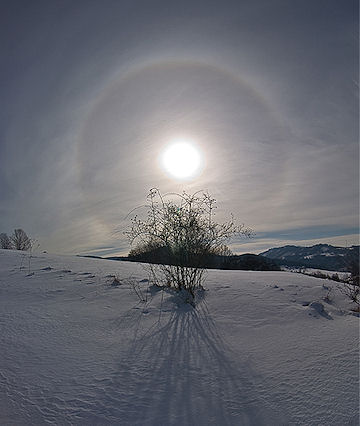NEW AND IMPROVED: Turn your iPhone or iPod into a field-tested global satellite tracker. The Satellite Flybys app now works in all countries. | | | GREAT FILAMENT, CONTINUED: For the seventh day in a row, an enormous magnetic filament is hanging suspended above the surface of the sun's southern hemisphere. The Solar and Heliospheric Observatory (SOHO) has a great view. How long can it last? Solar filaments are unpredictable. If this one collapses and hits the stellar surface, the impact could produce a powerful Hyder flare. Readers with solar telescopes are encouraged to monitor developments. MOON HALOES: The Moon is waxing bright and northern clouds are filled with ice. Add these two facts together, and you get a big zero in the sky: 
The "zero," or 22o moon halo, is caused by bright moonlight shining through ice crystals in high cirrus clouds. Martin Popek took the picture from Nýdek in the Czech republic on Feb. 22nd when the Moon was only half full. Imagine what this will look like on Feb 28th when the Moon is completely full with more than double the luminosity shown above. Sounds like a photo op! Photographers, ready your cameras, and be alert for moon halos. more images: from Tyler Allred of Tremonton, Utah; from Lorenzo Comolli of Tradate (VA), Pianura Padana, Italy; from Monika Landy-Gyebnar of Veszprem, Hungary BEAUTIFUL ENDEAVOUR: Shuttle launches have a reputation for great beauty. The view after a landing isn't bad either. Dr. Mark Staples sends this picture from the runway at Kennedy Space Center just after Endeavour returned to Earth on Sunday night: 
"I am part of the medical team of paramedics, decontamination specialists, firemen, nurses and physicians on hand to assist the astronauts and others in case of disaster," says Staples. "We're always glad we are not needed and thank the tremendous shuttle work force and team and crew for a job well done." Take a look at this shot. "That's a view you only want to see on a runway!" says Staples. The next shuttle mission to the International Space Station is just around the corner. If all goes according to plan, Discovery will blast off on April 5th at 6:27 am EDT. The pre-dawn launch should be spectacular--and the view from the runway when Discovery returns 13 days later won't be bad either. Stay tuned for coverage.
February Northern Lights Gallery
[previous Februarys: 2009, 2008, 2007, 2006, 2004, 2003, 2002] | 
